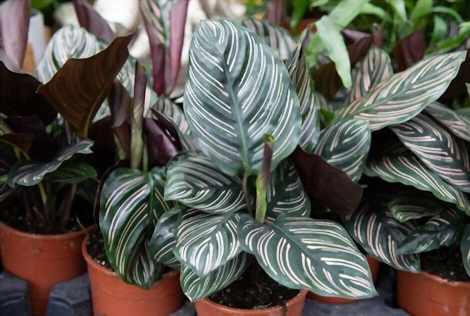Do you know that the Calathea Ornata is also known as the Pinstripe Calathea or Pinstripe plant? It is a breathtaking and eye-catching plant with pinkish stripes on its large green leaves.
It is a fine-looking plant but can be crabby and sometimes difficult to care for.
So after going through this guide cum article, you’ll have everything you need to know to keep your Calatheas blissful as we have tried to cover all the related points.
We will cover many points below, so stay tucked in your seats, get right into it, and learn more about your Pinstripe Calathea.
Calathea Ornata Care and Growth Guide:
1. Watering the Plant:
All Calatheas are wetness lovers. A large amount of water can be taken in by the Calatheas. However, there is a problem. When watering your plants, always drain the excess water.
Maintain a regular watering schedule for your pinstripe plant. Your soil shouldn’t become completely dry, nor should it become overly saturated.
To prevent mold and fungus growth on the Calathea ornata, the top of the soil should be allowed to dry out between watering. However, it should not be completely dry.
A plastic or terracotta pot will do fine for planting Calathea Ornata. Once that is done, could you place it in the decorative pot?
Overwatering can cause your plant to wilt and fail to recover from diseases and other afflictions caused by prolonged periods of dryness. To avoid potential problems, you must find a watering schedule that works for you and your plant.
According to the watering guide, this plant needs water every week or every two weeks depending on how dry the soil is. You can water this plant every two to four weeks in the winter.
2. Choosing Soil for the Calathea Ornata:
As referenced above, this plant loves to always be in damp soil. This means humidity-keeping soil is the best choice. This will help you in many ways as the plant will be healthy, and you won’t have to water it again and again.
Choose a soil that stays airy when moist. If you get soil that gets very heavy and clotty when watering, it’s a No. This soil won’t let any air go to the roots, which will slowly obstruct the plant. Soil with moss will be a great choice for this. It usually holds water and lets air through.
Choosing the right soil is one of the most important aspects of Pinstripe Calathea care. The right soil plays an imperative role in the growth of Calathea Ornata.
Related Article: Calathea Warscewiczii Care & Propagation (Perfect Guide!)
3. Calathea Ornata Light and Shade Requirements:
Calathea Ornata is a tropical plant, so they should get bright but indirect sunlight all day. Keep them close to a sun-facing window with a thin curtain or shade, and you should be able to keep your plant healthy.
If you don’t have a sun-facing window, a shaded one would also work without the curtain. Make sure it doesn’t get direct sunlight for too long because, in this way, the exquisite leaves will start to fade.
So, all in all, keep your plant in a bright spot where it gets indirect sunlight.
4. Humidity Requirements:
This plant loves to be in a moist, wet, and humid environment. To copy the tropical environment this plant prospers in, and it needs a lot of humidity. If you have a humidifier, keep it close to the Calathea and make sure it is in a humid environment.
5. Fertilizing the Calathea Ornata:
Calathea plants require relatively low amounts of fertilizing but benefit from a good general houseplant fertilizer every four weeks. This is especially the most important during the spring and summer when the Calatheas naturally grow a bit more. Fertilizing in the winter is unnecessary as the plant wilts during this season.
When your plant appears to be actively growing, don’t fertilize it. You might burn your plant if you fertilize during this stage. Fertilize with a balanced fertilizer to support growth.
Never think that over-fertilizing your Calathea plant will lead to increased production. If you fertilize your plant too much, the plant will become tall and skinny instead of lush and verdant.

6. Calathea Ornata Propagation & Repotting:
When you report your Calathea Ornata plant, use peat-based potting soil. Two parts of peat and one part of perlite is a good blend.
Repotting your Calathea plant shouldn’t be necessary until the roots and plant have grown quite large. Usually, this doesn’t happen until a year or more after you purchase your plant.
It would be best if you repotted your plants in the spring when they are ready. If you place the plant in a new pot during this period, the plant will be better prepared to deal with the effects of the new growth.
Once the plant has been growing for one or two years, move it to a larger pot. Depending on its size, you can divide the plant if you wish. To ensure the plant’s roots are healthy and well-established, mist it and water it regularly.
During repotting, separate clumps of leaves and leaf stalk if you want to divide the plant. To ensure new growth, ensure each clump of leaves has roots attached. As soon as the plant has been moved, cover it with polythene until new growth appears.
Also Read: Calathea Rufibarba Care (Propagation & Growing Tips)
7. Pruning And Maintenance:
Your calathea plant may occasionally have brown leaves. You don’t need to panic! There is nothing abnormal about this, and it simply means that your plant needs to be pruned back. Removing brown leaves is as simple as removing them as they appear. You can use pruning shears for this purpose, or you can use your fingers.
As well as maintaining the plant’s overall height, removing dead growth will help maintain a good growth pattern.
It may also be a good idea to dust your Calathea plant occasionally. To ensure the leaves receive adequate humidity, wipe the dust off the leaves with a clean, damp cloth before misting. If you have any yellow leaves remaining on your plant after dusting and wiping them down, you should remove them.
- Interaction with Pets and Children:
Many houseplants and decorative plants can harm pets and children, but fortunately, Calatheas are not one of those plants. It is safe for pets and won’t hurt them when they chew your plant. Like many other plants, you can safely put this plant wherever you want to, without any worries.
- Pest Problems and Diseases:
The Pinstripe plant is prone to a few pests, like spider mites. With some regular care, you should be able to keep this under control, though. A way to nutriment this pest is to clean the leaves with a mixture of water and dish soap in a spray bottle.
You can use this on the leaves, which will suffocate the pests on and inside the leaves. After this, you can wipe the leaves, and you should be set for the next few weeks. To be sure your plant stays away from this, you should repeat this process every one to two weeks.
- Signs of problems:
The Calathea Pinstripe can be an ill-tempered plant. As luck would have it, there are many early informing signs that your plant isn’t happy and healthy. Several symptoms include brown and crispy leaves, yellowing leaves, and fading pink stripes.
If this happens to your Calathea, it doesn’t mean it’s dying. If your plant is not receiving enough care, you are not giving it enough attention. If the leaves turn brown or light, the plant may be in an environment that’s too dry. In this case, make sure to mist your Calathea leaves daily to increase humidity.
The pink stripes on the leaves start to fade to white, indicating that the plant is getting too much sunlight. Move it to a place that’s a little more shaded, and you’ll see the difference for yourself.
FAQs
u003cstrongu003eDoes Calathea Ornatas need a lot of care?u003c/strongu003e
Yes, but some easy points about its care are mentioned above. This plant can stay healthy and beautiful if those points are carried out regularly.
u003cstrongu003eIs Calathea Pinstripe an indoor plant?u003c/strongu003e
Yes, The pinstripe houseplant can make a striking statement in your home. But houseplant care can be tricky, and extra effort is needed to look their best indoors.
u003cstrongu003eHow much water does Calathea Ornata need?u003c/strongu003e
Calatheas need to be watered anywhere from 1 time in a week to once every 2 weeks. The easy way is to check its moisture, and you’ll know when to water it.
Do Calathea Ornata leaves curl at night?
At night, Calatheas fold up their leaves and drop them during the day. Your plant may be getting too much light if you don’t see this movement but it is otherwise healthy.
Conclusion
And that’s it. The Calathea Ornata can be fussy, but once you stick to these points we discussed, you should be better prepared to take care of it. These guidelines will help you to realize signs and get solutions to keep your Calathea healthy and help it fly high.
Keeping track of your plant and having all the essentials in mind will make it grow healthy and happy, and obviously, that’s what you want.
Now you’re ready to get one of these amazing plants. Calatheas are beautiful and can even be easy to take care of only if you use the tricks from this article.
Related Article:

